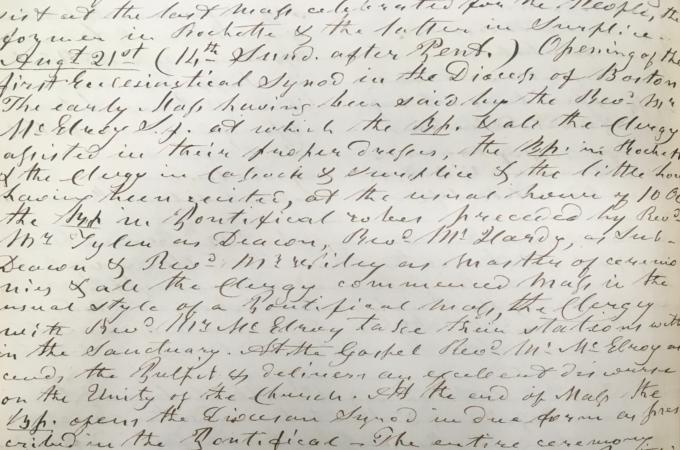The First Synod of the Diocese of Boston
Earlier this month, this column discussed a conflict between Bishop Benedict Fenwick and the parishioners of St. Mary's, Boston. In the context of a popular movement at the time, known as "Trusteeism," the parishioners believed that they, the lay people, should be able to govern their parish, not the bishop or diocesan administrators. This, and other similar episodes, prompted Bishop Fenwick to call for the first diocesan synod which met in August 1842.
The synod was a meeting of all priests from within the diocese called by the bishop so he could obtain their counsel through the discussion and debate of various issues. At this time, the issues were generally related to the rules and administrative procedures of the diocese, rather than of a theological nature, as with later synods. Unlike more recent synods, no laity or women religious were invited to attend.
To reiterate, Bishop Fenwick believed the events that had transpired at St. Mary's were the result of ambiguity over the roles of the clergy and laity in the governance of the Church. It has also been stated that advocates of Trusteeism saw the oversight of the Church by the laity as more democratic, and more suited to the new republic, than the current practices borrowed from the old world.
The 30 attendees gathered a week before the synod, on Aug. 12, 1842, for a weeklong retreat planned by Jesuit Father John McElroy, who would later found Boston College in 1863. Each day, participants were expected to rise at 5 a.m., praying, meditating, and reflecting privately in their room until Mass at 6:45a.m. The remainder of the day was largely filled with sessions of more prayer, meditation and reflection, but also lectures and discussion upon a variety of topics. There were two breaks, an hour for lunch in the afternoon, and time for supper in the evening. Priests were expected to retire to their rooms by 9 p.m.
The retreat continued until Saturday, Aug. 20 with the opening of the synod occurring the next day. On Sunday, the priests made their way to the Cathedral of the Holy Cross on Franklin Street for Mass, a celebration in which many of Boston's Catholics participated. Bishop Fenwick wrote that "the Church was never more crowded -- every inch of the Pews, aisles and galleries were occupied" by the laity. Father McElroy spoke at the Mass and, as is custom, all the priests received Communion from Bishop Fenwick. At the conclusion of the Mass, he declared the synod open.
The real work commenced the following day, with the future Bishop of Boston, John Father Bernard Fitzpatrick, serving as secretary, Father William Tyler as promoter, and Father Jeremiah O'Callaghan as procurator. Each day was preceded by Mass, and during the first three days the decrees of the first four Provincial Councils of Baltimore were discussed; specifically, how the decrees could best be applied to the local situation. On Aug. 25, the fourth day, Bishop Fenwick wrote that attendees shared their "opinions upon various points as to their practicability in this Diocese," and they named committees "for the examination of the State and Property of all the Churches in the Diocese." That afternoon, each committee reported on the revenues, debts, and condition of the buildings at each parish in the diocese. On the final day, Aug. 26, the 22 approved statutes were read aloud by Father Fitzpatrick and, after a short address by Bishop Fenwick, the synod was adjourned.
In direct response to Trusteeism, the synod decreed that all Church property, with the exclusion of that owned by religious orders, was owned by the Bishop of Boston. In addition, those priests who advocated among their parishioners in favor of Trusteeism would be suspended.
The authority of the bishop over his priests did not stop there. Further decrees forbid priests from being absent from their assigned parish for more than one week, or publishing a work on a religious subject, without first receiving permission from the bishop. In addition, they were not allowed to administer sacraments outside of their assigned territory, and were required to keep a written record of those they administered.
Finally, several decrees pertained to worship, including the music that was played at Mass, and forbidding churches to hold midnight Mass at Christmas and collecting money at the church doors.
The second synod would not be held until 1868, when Bishop John J. Williams called for one shortly after succeeding Bishop Fitzpatrick, wishing to outline the rules of his administration. There had also been another Provincial Council in Baltimore in 1866 to discuss issues raised by the American Civil War, and much as they had earlier the priests in the diocese gathered to debate and enact the decrees from that council in a local context.
- Thomas Lester is the archivist of the Archdiocese of Boston.



















